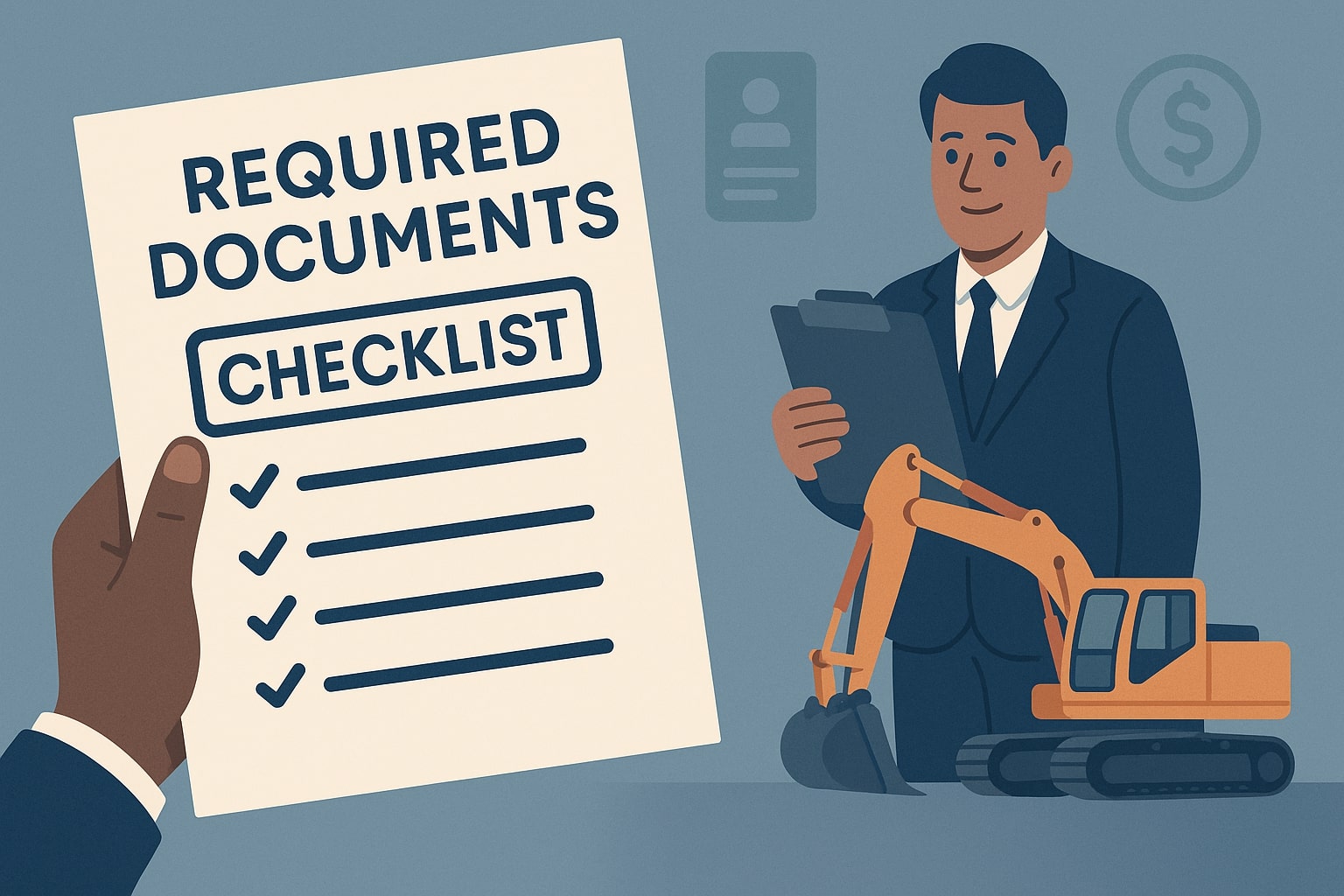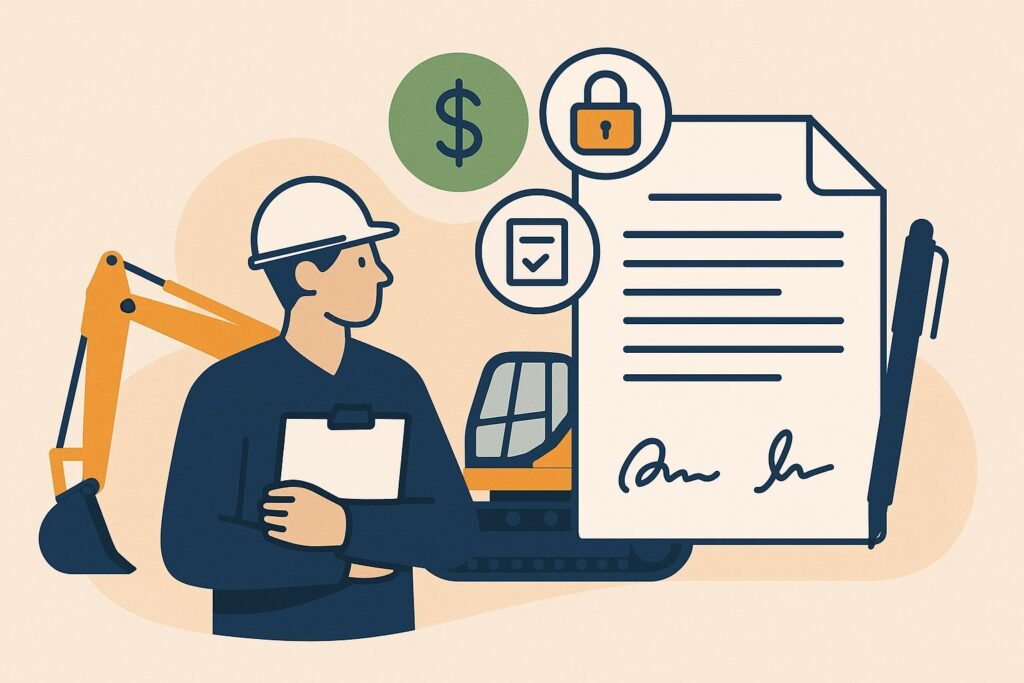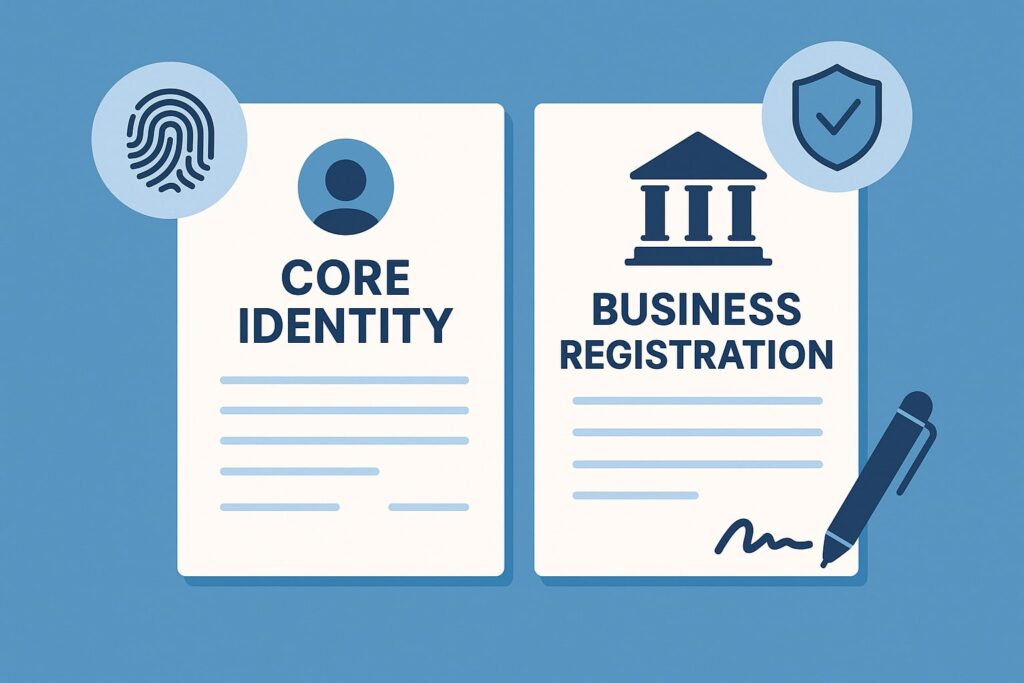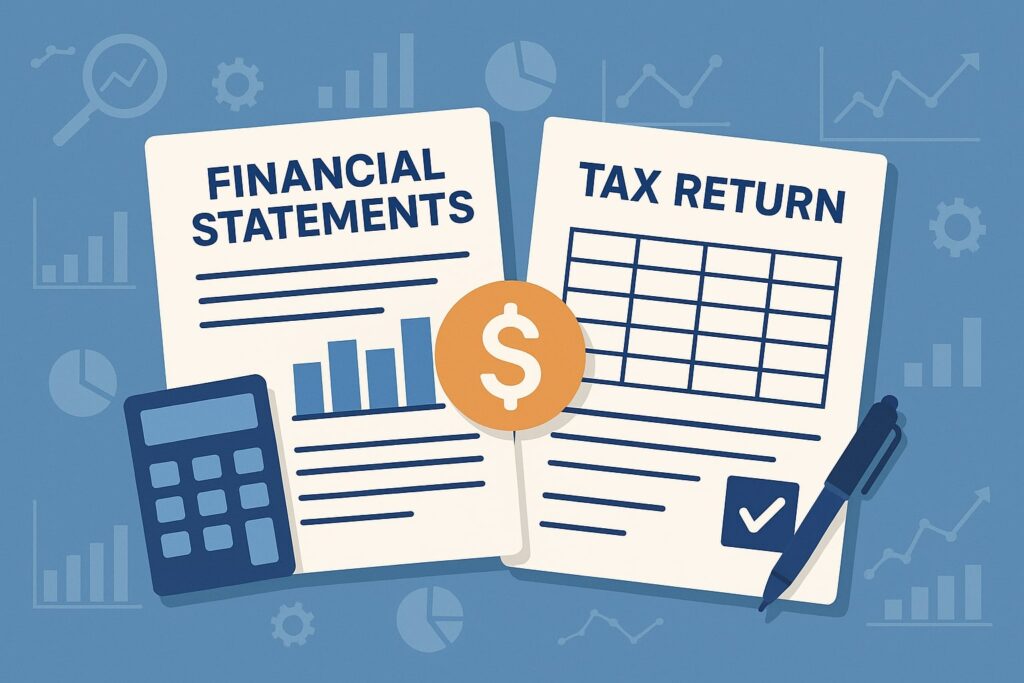
Required Documents Checklist for Equipment Loan Applications
Ready to secure financing for new machinery, vehicles, or technology? This comprehensive required documents checklist for equipment loan applications explains exactly what lenders expect in the United States today.
You’ll find plain-English explanations, detailed sub-checklists, and current compliance notes so your file is clean, accurate, and fundable. Use these sections to build a lender-ready package, cut underwriting delays, and improve approval odds for your equipment financing request.
Understanding Equipment Loans and Why Documentation Matters

An equipment loan is a credit facility used to purchase or refinance business-use equipment. The asset itself often serves as primary collateral, which helps keep rates competitive and terms flexible.
Because lenders rely on the asset and your cash flow to repay the note, a tight equipment loan application checklist is essential. Underwriters verify your identity, legal standing, ability to repay, and the value of the equipment. Any gaps slow the file or trigger conditional approvals that add time and cost.
Most U.S. small businesses encounter two paths. Traditional banks and credit unions offer lower rates but require fuller documentation. Independent equipment finance companies move faster but still need a complete package.
SBA-backed options (7(a) and 504) bring longer terms with form-heavy files. In every case, a lender decides based on consistent data across your articles of formation, tax returns, bank statements, and equipment quotes.
Use this required documents checklist for equipment loan applications to present a coherent story the first time, not the third.
Core Identity & Business Registration Documents

Lenders must confirm your identity and your company’s legal existence. Missing entity paperwork is one of the top reasons files stall. Gather these items before you even ask for a quote.
What to include
- Government ID for each owner with 20%+ interest: unexpired driver’s license or passport.
- Employer Identification Number (EIN) assignment letter from the IRS.
- Business formation documents: Articles of Incorporation/Organization and state Certificate of Good Standing (recent).
- Operating Agreement (LLC) or Bylaws and any Amendments naming authorized signers.
- Assumed name/DBA filings, if you market under a trade name.
- Business license(s) if your city or county issues them.
- W-9 for your business with correct legal name and tax classification.
Why it matters
Underwriters compare your legal name, EIN, and ownership list across all documents. Any mismatch, like a DBA on bank statements but not on formation papers, creates re-verification work.
Avoid this by using identical legal names on your equipment loan documents from the start. Also ensure your good-standing certificate is recent so the lender knows your entity is active and compliant.
Financial Statements and Tax Returns

Your financials prove the business can support the new debt. Even if the loan is “asset-based,” lenders still model debt service coverage using your historical and projected numbers.
What to include
- Year-end business tax returns for the last two years (complete returns, all schedules).
- Interim Profit & Loss and Balance Sheet dated within 60–90 days, with prior-year comparison.
- CPA-prepared or internally prepared statements with clear accrual vs. cash basis noted.
- Personal tax returns for each guarantor for the last two years, if required.
- Accounts Receivable (A/R) and Accounts Payable (A/P) aging reports, current and accurate.
Tips for clean files
Make sure subtotals and retained earnings roll forward correctly. If you changed accounting systems, include a short memo that explains the transition and any mapping differences. For growing firms, footnote one-time expenses that depress net income.
Underwriting teams appreciate concise context that ties your numbers to the growth the new equipment will unlock.
Bank Statements and Cash-Flow Proofs
Bank statements are the fastest way to verify revenue inflows and operating expense outflows. They help the underwriter validate your debt service capacity and catch red flags early.
What to include
- Three to six months of operating account statements (all pages, even blanks).
- Statements for any payroll, tax, or merchant settlement accounts.
- Explanations for large non-recurring deposits or transfers.
- Voided business check or bank letter for ACH set-up at closing.
Best practices
Download original PDFs from your bank portal so the metadata remains intact. Avoid screenshots and stitched images. If your business is seasonal, highlight that pattern in a one-paragraph note and provide an extra six months of statements to show the full cycle.
This proactive detail strengthens your required documents checklist for equipment loan applications and reduces follow-up conditions.
Business Debt Schedule and Credit Authorization
A current debt schedule shows every note your business is already servicing. Lenders use it to calculate global debt payments and make sure your equipment loan application checklist supports affordability.
What to include
- Business Debt Schedule listing lender name, original balance, current balance, interest rate, monthly payment, maturity date, and collateral.
- Explanation for any balloon payments.
- Credit authorization forms signed by authorized owners/guarantors.
Why it matters
If you plan to refinance an existing equipment note as part of the transaction, flag that clearly and include the payoff letter request details. Underwriters check that your new payment fits alongside existing obligations. A precise, up-to-date schedule speeds approvals and avoids surprises near closing.
Equipment-Specific Documents (Quotes, Invoices, Specs, and Appraisals)
The equipment is the heart of the deal. Your lender needs accurate descriptions to validate value, set loan-to-value (LTV), and confirm the asset’s useful life.
What to include
- Vendor’s formal quote or pro forma invoice with make, model, year, options, serial/VIN (if known), and total price including taxes, freight, and install.
- New vs. used status; for used equipment, include hours/mileage and photos.
- Purchase Agreement or Purchase Order with terms, delivery timeline, and any deposits.
- Appraisal or inspection report for large, specialized, or used assets when required.
- Build sheets, spec sheets, and warranties.
Pro tips
Align the equipment description exactly across all equipment loan documents. If your quote says “CNC Lathe Model X,” your purchase order and insurance binder should mirror that description. Consistency reduces back-and-forth and protects you if questions arise after funding.
Collateral, Liens, and UCC Filings
Even when the equipment secures the loan, lenders look for prior liens that could prime their position. Clearing or subordinating conflicts early prevents last-minute closing crunches.
What to include
- List of existing UCC-1 filings against your business and any blanket liens.
- Payoff letters or lien releases for obligations you’re retiring with proceeds.
- Subordination or intercreditor agreements if another lender will remain in first position on certain assets.
- Collateral schedule if multiple assets secure the note.
Action steps
Ask your lender whether they’ll file a blanket UCC or an equipment-specific filing. If your bank has a blanket lien for a line of credit, coordinate early for either subordination or carve-out language. Document this plan in your required documents checklist for equipment loan applications so everyone stays aligned.
Insurance and Risk Management Documents
Lenders require evidence that the equipment will be protected as soon as it’s delivered. You’ll typically need general liability and property coverage, plus endorsements naming the lender.
What to include
- Certificate of Insurance (COI) with the lender listed as loss payee or additional insured as applicable.
- Evidence of equipment floater or inland marine coverage during transit and installation.
- Workers’ compensation coverage if the equipment introduces new staffing risk.
- For vehicles: commercial auto policy with appropriate limits.
Timing tip
Ask your broker for a draft COI early, showing the exact equipment description and lender wording. This allows the lender to pre-clear insurance language before closing, avoiding day-of-funding edits that delay equipment release.
Legal and Compliance Documents (KYC/AML, OFAC, and Beneficial Ownership)
U.S. lenders follow strict identity and anti-money-laundering rules. Expect to provide ownership details and answer compliance questions as part of your equipment loan application checklist.
What to include
- Ownership chart listing all persons with 25%+ ownership and any control party.
- Addresses, dates of birth, and IDs for beneficial owners and control persons.
- Patriot Act/OFAC compliance acknowledgments and screening consents.
- Any litigation, bankruptcy, or tax lien disclosures with supporting documents.
Current note
Beginning in 2024, many corporations and LLCs must file Beneficial Ownership Information (BOI) reports under federal law. While your lender doesn’t file for you, they may ask whether you’ve complied and may request your ownership details mirror that filing. Keep an updated ownership list and be ready to certify accuracy.
Industry-Specific Permits, Certifications, and Environmental Items
Certain sectors trigger added documentation to manage safety, regulatory, or environmental risk. Provide these with your initial package to keep underwriting smooth.
Examples
- Transportation: DOT/MC authority, CDL validations, ELD compliance, and maintenance logs for used tractors.
- Construction & Mining: OSHA safety programs, site permits, and any required heavy-equipment certifications.
- Healthcare: Facility licenses, equipment accreditation, and OEM service agreements for imaging or lab devices.
- Food & Beverage: Health department permits, HACCP plans, and equipment sanitation specs.
- Energy/Environmental: Emissions certifications, spill prevention plans, and environmental assessments when applicable.
Tip
Ask your vendor for industry compliance sheets. Including them in your required documents checklist for equipment loan applications reduces questions and shows the asset is fit for purpose in your jurisdiction.
Projections, Business Plan, and Use-of-Funds Narrative
Underwriters want to see how the equipment will generate or protect cash flow. A short, focused narrative plus realistic projections can be the difference between approval and denial.
What to include
- 12–24-month revenue and expense projections showing the new loan payment.
- Assumptions for utilization, pricing, labor, and consumables.
- Simple ROI or payback analysis (hours × rate × utilization minus operating costs).
- One-page business plan or executive summary linking market demand to equipment capacity.
Keep it practical
Tie your numbers to real contracts or purchase orders when possible. If you can pre-load a pipeline of jobs the equipment will fulfill, attach those LOIs or agreements. Clarity in this part of your equipment loan application checklist signals execution readiness.
Guarantor Documentation and Personal Financial Statement
Most small-business equipment loans require a personal guarantee from principal owners. Lenders analyze personal capacity, contingent liabilities, and liquidity.
What to include
- Signed Personal Financial Statement (PFS) for each guarantor, dated within 60 days.
- Supporting statements for cash, investments, and retirement accounts.
- Real estate schedule with addresses, values, liens, and payments.
- Personal credit authorization and explanations for any derogatory items.
Pro tip
If you’ve had a prior credit event, a brief letter that explains what happened, how it was resolved, and why it won’t recur can neutralize concerns. Keep the tone factual and organized.
SBA Equipment Financing: Extra Forms and Evidence
SBA-backed loans add formality but can deliver longer terms and lower payments. Expect a broader required documents checklist for equipment loan applications when SBA 7(a) or 504 is involved.
What to include (typical)
- SBA borrower information forms for each owner and key manager.
- Personal history and background questionnaires.
- Business debt schedule on SBA format.
- Three years of business and personal tax returns.
- Interim financials and projections with assumptions.
- For 504: project cost breakdown, third-party lender commitment, and CDC involvement.
- Affiliation details if you own interests in multiple companies.
Strategy
Start assembling SBA items early. Many delays happen when owners wait to gather personal returns or complete background forms. A complete SBA packet can still move efficiently when the rest of your equipment loan documents are tight.
Startups vs. Established Businesses: What Changes?
Startups without full tax history can still finance equipment. The lender will lean more on projections, personal credit, and down payment. Established firms rely on historical cash flow and may qualify with less money down.
For startups
- Strong business plan, market analysis, and signed contracts or LOIs.
- Larger equity injection or additional collateral.
- Guarantor liquidity statements and resume(s) showing relevant experience.
For established companies
- Clean, consistent financials and bank statements.
- Evidence of equipment replacing rentals or outsourcing costs.
- Maintenance plan demonstrating long-term operability.
Whichever stage you’re in, your equipment loan application checklist should tell a consistent story about how the asset improves revenue or lowers cost per unit.
Vendor and Dealer Participation: The “Lender-Ready” Sales Packet
If you’re a vendor offering financing referrals, help your buyers close faster by packaging the essentials. This improves approval rates and reduces quote-to-cash time.
What to include
- Formal quote with full specs, serial/VIN placeholders, and delivery timeline.
- Photos, brochures, and warranty summaries.
- Used equipment disclosures: hours, maintenance records, and inspection notes.
- Draft bill of sale and installation plan.
- Contact person for insurance certificate wording and site access.
Vendors who send a complete packet aligned to this required documents checklist for equipment loan applications speed up underwriting and get funded sooner.
Digital Submission Best Practices (File Types, Naming, and E-Sign)
Clean digital files keep your application moving. Underwriters deal with dozens of submissions each day. Make yours the easy one.
Tips
- Use original PDFs, not scans of printouts. Combine multi-page statements into one file.
- Name files consistently: ABC_Mfg_2024_BS_IS.pdf, Excavator_Quote_DealerX.pdf, OwnerID_JSmith.pdf.
- Redact SSNs except last four when permissible; share full SSNs only through secure portals.
- Sign via e-signature when allowed; ensure the signer matches the authorized person in your entity documents.
- Create a single folder structure that mirrors this equipment loan application checklist so items are easy to find.
Common Red Flags and How to Fix Them Before You Apply
Preventable issues derail otherwise good applications. Scrub your file first so underwriters spend time approving, not triaging.
Watch for
- Name mismatches between bank accounts, tax returns, and formation papers.
- Large unexplained deposits in bank statements.
- Out-of-date debt schedules or missing guarantor PFS.
- A/R aging with heavy 90+ day balances and no collection plan.
- Insurance certificates with incorrect lender wording or coverage gaps.
Fixes
Add short, factual explanations. Update aging reports. Obtain payoff letters and lien releases. Get a draft insurance binder early. Tightening these details elevates your required documents checklist for equipment loan applications from acceptable to excellent.
State Taxes, Incentives, and Section 179 Documentation
Tax treatment can influence your financing strategy and closing requirements. While lenders don’t give tax advice, they often request proof of elections or exemptions that affect the invoice.
Consider
- Sales/use tax exemptions for manufacturing or agricultural equipment (submit certificates).
- Section 179 or bonus depreciation planning with your CPA; keep a memo for your file.
- Property tax filings for certain movable equipment in your state.
- For titled vehicles, registration requirements that affect timing.
Attach any exemption certificates or CPA memos to your equipment loan documents so your vendor invoices and lender amounts match.
Timeline and Process Map: From Application to Funding
Understanding each step helps you keep momentum and set realistic expectations with your team and vendor.
Typical flow
- Pre-qual & checklist: share core documents for a soft review.
- Conditional approval: lender issues a terms sheet with conditions.
- Underwriting: deeper review of bank statements, tax returns, and collateral.
- Closing package: loan agreements, guarantees, insurance, and UCC prep.
- Funding: vendor paid per bill of sale, with delivery and acceptance.
Keep all stakeholders—CPA, insurance agent, vendor—looped in. A coordinated approach turns your equipment loan application checklist into a predictable timeline rather than a guessing game.
Final Pre-Funding and Closing Checklist
The last mile is where small details matter. A precise closing checklist prevents wire-day surprises.
Bring together
- Final invoice matching loan amount and equipment description.
- Signed loan and security agreements; personal guarantees.
- Insurance COI with final lender wording and effective dates.
- UCC filing authorization and any subordination agreements.
- ACH authorization and voided check.
- Delivery/installation schedule and acceptance certificate template.
Confirm wiring instructions with the vendor by phone and capture that confirmation in writing. Your required documents checklist for equipment loan applications should end with a brief “funding day” plan so everyone knows who does what and when.
Frequently Asked Questions (FAQs)
Q1) Do I need personal tax returns for an equipment loan?
Answer: Often yes, especially for small businesses or when owners provide a personal guarantee. Lenders use personal returns and a Personal Financial Statement to assess overall capacity and liquidity. Include both in your equipment loan documents if requested.
Q2) How many months of bank statements should I provide?
Answer: Plan for three to six months. Seasonal businesses may need more to show a full cycle. Provide the official PDFs, all pages included.
Q3) Will the lender require an appraisal for used equipment?
Answer: For larger or specialized assets, yes. Expect an appraisal or inspection. Smaller deals may rely on dealer quotes and photos.
Q4) Can I finance soft costs like shipping and installation?
Answer: Often yes. Include those line items on your quote so they’re part of the equipment loan application checklist and reflected in the funding amount.
Q5) What if my business has a blanket lien with another bank?
Answer: You’ll coordinate a lien release, payoff, or subordination. Engage both lenders early and include expected steps in your checklist.
Q6) How do I handle ownership changes before closing?
Answer: Avoid changing ownership mid-underwrite. If needed, document it with updated formation papers and a fresh ownership chart so all equipment loan documents match.
Q7) Are startups eligible for equipment loans?
Answer: Yes, with stronger guarantor support, down payment, and projections. Signed contracts or letters of intent help demonstrate revenue.
Q8) Do I need a business plan for established companies?
Answer: A concise plan and projections help any application. Even mature firms benefit from a clear use-of-funds narrative and ROI.
Q9) How fast can I fund once approved?
Answer: Speed depends on how complete your required documents checklist for equipment loan applications is. Insurance, UCC coordination, and vendor confirmations are common pacing items.
Q10) Will Section 179 affect my loan approval?
Answer: Not directly, but it affects your tax strategy and invoice details. Coordinate with your CPA and share any exemption certificates that change the billed amount.
Conclusion
Winning an approval is about clarity, completeness, and consistency. A polished required documents checklist for equipment loan applications presents your identity, capacity, and collateral in a way underwriters can validate quickly.
Gather your entity papers, tax returns, bank statements, debt schedule, and equipment quotes. Add insurance proofs, ownership details, and any industry permits.
For larger or used assets, line up inspections, appraisals, and lien solutions early. Tie it together with a simple use-of-funds story and cash-flow projections that support repayment.
By using this guide as your working equipment loan application checklist, you minimize conditions, shorten time to funding, and get your asset on the floor, the road, or the line—doing the job you bought it to do.